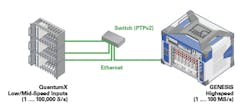DAQ: PTPv2 holds data acquisition and testing to a tight schedule
Over the last few decades, many different timing mechanisms have been used to synchronize the operation of data-acquisition and test-and-measurement devices. However, for synchronizing the operation of distributed systems, using the established Ethernet infrastructure is essential because it offers high flexibility and ease of use at a relatively low cost.
Ethernet is the de facto worldwide standard for machine-to-machine or human-to-machine communications. Even mobile devices like smartphones and vehicles can be linked to Ethernet-based networks through mobile telecom networks. The IEEE 1588:2008 Precision Time Protocol (PTPv2) was developed to support highly accurate time synchronization of distributed systems like data acquisition modules in test-and-measurement applications.
In test-and-measurement applications, highly accurate timestamped signal inputs representing the same physical process captured at the same moment play an important role in qualifying and analyzing measurement data in the post-processing mode.
Absolute time vs. relative time
Absolute time accuracy is needed when measurement data must be mapped to a specific real-world event or when two or more data-acquisition systems are not on the same network. An example in which absolute time might be relevant would be when it’s essential to monitor the load influence of a train crossing a bridge and identify the train to support further actions such as issuing an overload warning. The absolute time is explicitly available when it is represented by a clock.
Most test-and-measurement applications or processes can use a relative system time, particularly when a test is reproducible and what matters most is the relative timing of the signals to each other. Sometimes, time accuracy can be confused with reaction, latency, or real time. Real time refers to deterministic behavior—a “decision” or “response” that needs to be done within a specific time frame and is used mainly in control or automation tasks in which a control algorithm issues an output based on input from a sensor.
Time latency must be taken into account when designing control algorithms or when a response is needed within a given maximum time. Real-time control applications normally require fixed and very low time latency from the sensor to the controller. For nondeterministic protocols like Ethernet TCP/IP, CANbus, or any PC-based activity, time latency is variable. Time latency also plays a role when data is streamed to a real-time controller for monitoring purposes in case the timestamp sent with the data value is not or cannot be considered.
Hardware- vs. software-based timestamping
PTPv2 is based on Ethernet. Unlike Network Time Protocol (NTP), PTPv2 is embedded in the physical layer, which allows for true hardware-based timestamping for precise time synchronization of all participants in an Ethernet network. The main difference between hardware- and software-based timestamping is the synchronization accuracy achievable. With software-based timestamping (used in NTP, for example), slave synchronization accuracies down to 100 μs are possible in small networks but typically are more on the order of 1 ms. In contrast, with hardware timestamping like PTPv2, it is possible to achieve time synchronization accuracy down to 50 ns. However, to obtain this level of accuracy, the network topology such as switches and slave hardware must support hardware timestamping.
How PTPv2 works
PTPv2 is a relative time sync mechanism. One participant is selected to work as the master clock, which delivers time sync messages to all slaves. The sync process starts with a time sync telegram to the network. All participants (slaves) calculate the time difference (delay) between their local time and the given master clock and adapt step by step to a time difference less than 2 µs.
PTPv2 applications
PTPv2 offers some major advantages over other synchronization methods for a wide range of data acquisition applications:
- Supports time synchronization between different device types from different vendors via a standardized protocol.
- Allows for large distances between data acquisition modules (electrical, optical).
- Supports synchronization of different product lines from the same manufacturer with each other. For example, HBM’s QuantumX, SomatXR, and GENESIS High Speed systems offer PTPv2 synchronization and can work together to enable data acquisition in both distributed applications in harsh environments and in lab settings with hundreds of channels and high speeds.
- Ensures high time accuracy (in the submicrosecond range) between all participants when working with high data rates.
- Provides for simple, administration-free setup, including automatic master selection, high robustness, and a continuous time scale with no “jumping” time stamps and no rollover.
- Supports absolute timing when necessary. A grandmaster clock based on GPS can be integrated to serve as an absolute time source when one or more data acquisition systems are not in the same network but the resulting data needs to be analyzed quickly.
A number of applications highlight the advantages that PTPv2 time synchronization offers. For example, it allows data gathered from widely distributed data acquisition modules (Figure 1) to be used to study complex interactions, such as braking dynamics and structural stability of large ground transportation vehicles like trains and construction equipment. Figure 1 shows a widely distributed topology based on the modular QuantumX data acquisition system, which is capable of acquiring signals from any type of analog sensor. The modules often are used in monitoring and testing applications because their universal inputs provide maximum interference suppression for the acquisition of strain, force, displacement, acceleration, rotational speed, pressure, temperature, voltage, current, and many more.
Operators of today’s complex electrical power grids use time-tagged measurements of voltage and current throughout the power grid to monitor and control grid performance. PTPv2 synchronization allows operators to monitor the relationships between voltage and current due to reactive loads, compare the phase of two voltages that might be connected together to divert power from one part of the grid to another, or monitor the harmonic content of the signal. Often, important data is aggregated from multiple data acquisition locations, and it must be synchronized so that the data can be directly compared in time.
Systems that support PTPv2 also are well suited for structural health monitoring of the stability of large engineered structures such as bridges, towers, or wind turbines using GPS-based absolute time signals.
PTPv2 is invaluable for synchronizing data produced by distributed data-acquisition modules during ground-based structural durability testing of new aircraft. It also supports synchronizing data acquired under the control of a flight simulator using so-called “iron birds.” By using an iron bird as a testbed, data from various measurement sensors is synchronized and recorded for later analysis. An iron bird can be “flown” like a standard aircraft from a simulated flight deck, with a computer generating the aerodynamic model and environmental conditions like air density, air temperature, airspeed, and Mach number. Aeronautics engineers use these tools to incorporate, improve, and validate vital aircraft systems, including electrical and hydraulic generation and flight controls. Iron birds allow these engineers to confirm the characteristics of all system components during early development stages and discover any incompatibilities that may require redesign or modifications.
PTPv2 is equally suitable for hybrid applications (Figure 2) that combine high-speed acquisition with high channel counts, such as for dynamometer testing of new electric or hybrid vehicles. For example, one automotive industry customer has used HBM’s GENESIS high-speed data acquisition system to acquire voltage and current data in sync with the modular mid-speed QuantumX system used to acquire temperature sensor data and CANbus signals.
GENESIS high-speed systems are widely used for high-speed data acquisition and transient recording because they can have from four to 4,320 channels with sampling rates up to 100 MS/s per channel. They support continuous direct-to-disk streaming at up to 200 MB/s.
Testing of an aircraft’s electrical grid and components is another example of the use of a hybrid architecture that depends on PTPv2 synchronization. Engineers study electrical switching with variable interruptions and times to assess their impact on the computers and other components; the complete system assembly also is tested to gage the effects of electromagnetic interference.
About the author
Christof Salcher is the product and application manager for test and measurement and data acquisition systems at HBM (Hottinger Baldwin Messtechnik GmbH), headquartered in Germany. He holds a Dipl.-Ing. in electrical engineering and has more than 20 years of experience in the data acquisition industry.



